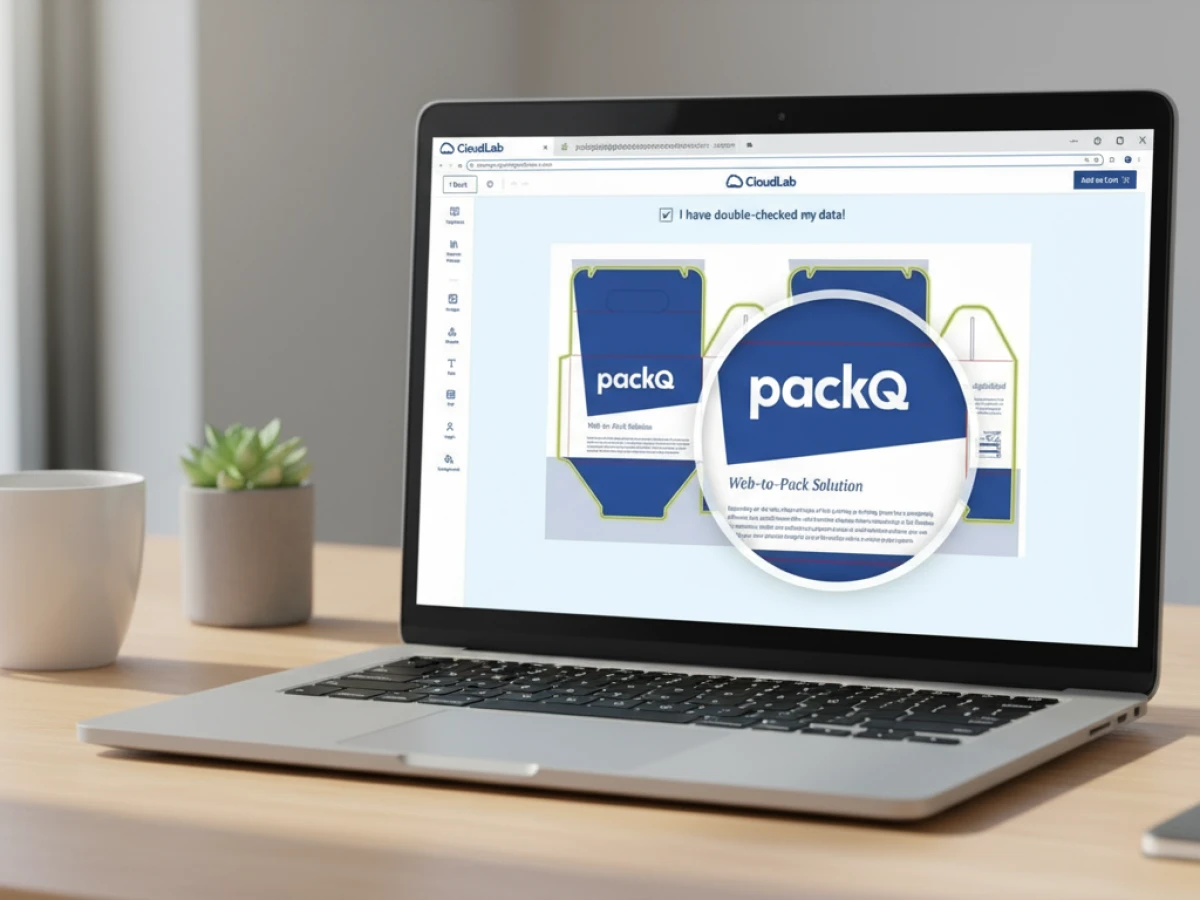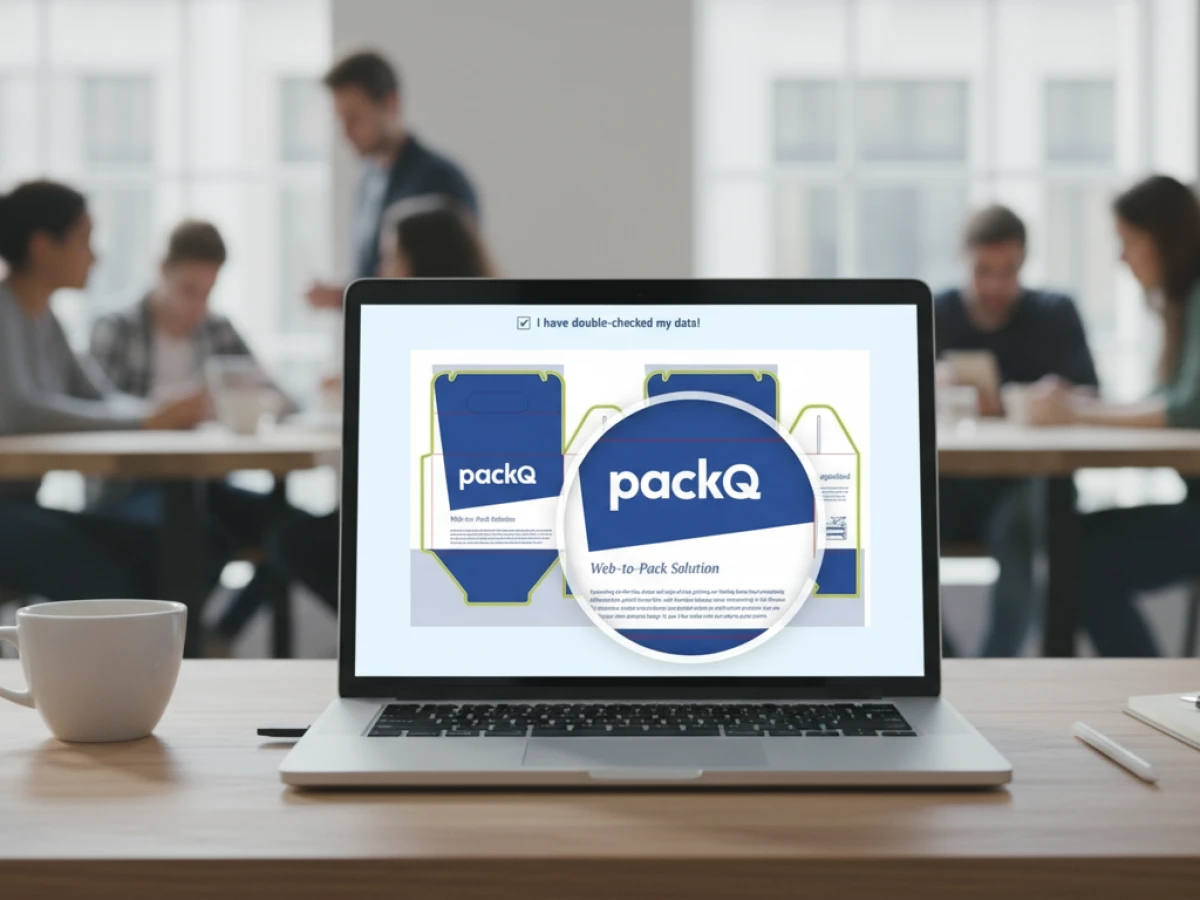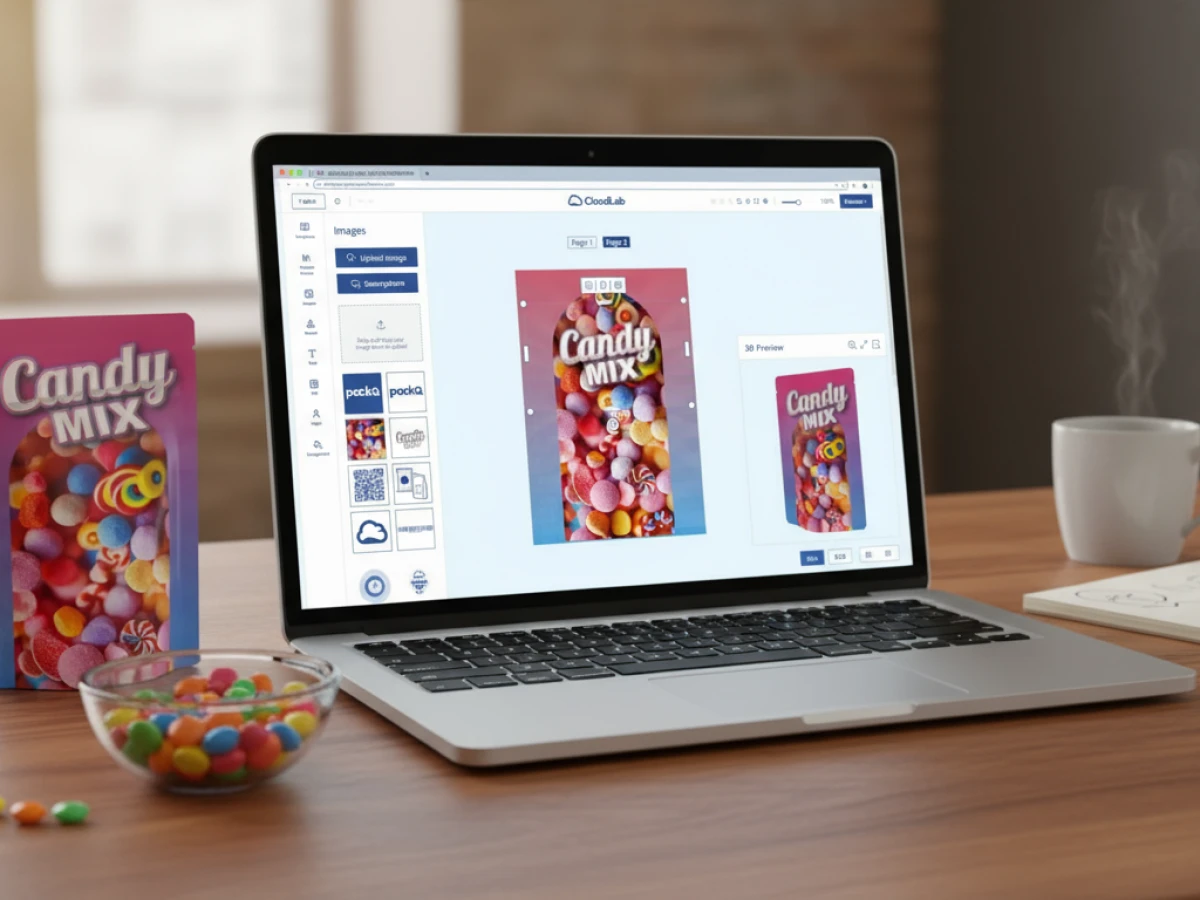Dimensionally Variable Packaging Design – Flexible, Dynamic and AI‑Driven

Dimensionally variable package design combines parametric construction with AI‑driven layouts. In packQ, templates automatically adapt to individual dimensions so that boxes, displays and pouches can be created in any size. This article explains the technology, its benefits and shows practical examples.
Packaging design as brand ambassador
Packaging is more than a product protector – it’s a crucial ambassador for a brand. Whether folding carton, corrugated box or flexible pouch: the design must be aesthetically pleasing, functional and economical. In practice, companies face a challenge: product sizes change, campaigns require different formats and customers expect individual dimensions. Classic layouts quickly reach their limits because they are created for a fixed size. Adjusting them usually requires a designer and costs time and money.
This is where dimensionally variable packaging design comes into play. In packQ this means templates that automatically adjust when length, width or height change. Behind this convenience is a combination of parametric geometry, design rules and artificial intelligence. This article explains how this technology works, what advantages it offers and why it’s a must for modern packaging production.
Parametric design: foundation of flexibility
Parametric design is based on defining shapes through parameters. For a folding carton these might be the AWH dimensions:
- A/L: the length between the side flaps
- W: the width of the package
- H: the height parallel to the glue seam
If one of these values changes, the entire construction is recalculated. Flaps, glue tabs, tuck flaps and fold lines automatically adjust. This method is known from CAD programmes like ArtiosCAD, but packQ brings it into the web browser and makes it usable without specialised knowledge.

Advantages of parametric geometry
- Time savings: Instead of creating a separate cutting die for each size, one template dynamically adapts.
- Reduced errors: Mathematical rules prevent proportions from being distorted or tabs being too small.
- Uniform appearance: All variants look like they’re from a single mould because spacings and proportions remain consistent.
- Cost reduction: Less need for individual CAD drawings means lower construction costs.
packQ uses these principles in its ECMA and FEFCO library. More than 120 folding cartons and 290 corrugated models are parametrisable. The user enters the desired dimensions and immediately receives the finished die – including bleed allowances, fold lines and glue flanges. Similar libraries exist for POS displays, flexible packaging and pouches.
Liquid Layouts: AI‑driven design
Parametric shapes solve the construction problem, but how does the design stay aesthetic? A logo should not be pushed to the edge on a small box and a text block mustn’t run across a crease. This is where Liquid Layouts come in. The concept originates from web and editorial design, where page layouts adapt to different screen sizes. packQ transfers this idea to packaging.
How Liquid Layouts work
- Template as starting point: Designers create a master design with fixed placeholders for logos, text, images and finishing areas. They define rules for how these elements should react when size changes (relative spacing, scaling or reordering).
- AI‑based rules: The packQ AI has been trained with design principles. These include colour contrast, proportional rules like the golden ratio, harmonious grids, minimal white space and the hierarchy of content elements. Based on these, the AI decides how to move or scale elements to keep the layout balanced.
- Responsive calculation: When the user enters other AWH dimensions, packQ recalculates the new sizes for each panel. The engine analyses all elements: it reduces images proportionally, breaks texts, adjusts font sizes and moves elements if necessary. Even the relationship between front and back is considered.
- Real‑time preview: During configuration the user sees the effects of their inputs immediately in 3D. Changing the height shows how the text flows and whether the logo remains centred.
Benefits of Liquid Layouts
- Design without expert knowledge: Even non‑designers can create high‑quality packaging because the AI assumes design guidelines.
- Faster time to market: Companies don’t need to commission a designer for every size. One template covers multiple variants.
- Consistent brand appearance: Logos, colours and fonts remain harmonious across all sizes – vital for corporate identity.
- Freedom to experiment: Designers can play with new proportions without fear of destroying the layout. The AI acts as a safety net.
Responsive AI adjustments: fine‑tuning for perfect results
The template approach works because packQ analyses each element separately. The system considers several levels:
- Panel level: Each side of the package is handled separately so that the front, back and side panels can have different rules.
- Element level: Objects are prioritised based on importance. A brand logo is weighted higher than a decorative pattern. When space is tight, the pattern is reduced first.
- Typography rules: Readability takes precedence. packQ reduces fonts only to a minimal limit, splits text into sensible lines and sets line breaks at suitable positions.
- Colour coordination: Changing size affects colour perception. The AI adjusts contrasts so areas don’t dominate.
All these adjustments happen invisibly in the background. For the user only the result counts: no matter which format is chosen – the design appears thoughtful and attractive.

Practical examples of dimensionally variable design
Cosmetic line in various sizes
A natural cosmetics start‑up sells creams and lotions in 30 ml, 50 ml, 100 ml and 200 ml. The packaging should look like a family on the shelf, but each size requires different proportions so information fits. Using packQ, designers create a template with Liquid Layout. The AI ensures the logo and product name are always prominently placed and mandatory text remains legible. The packages have different dimensions but look like parts of a series.
Shipping boxes for e‑commerce
An online retailer uses tailored shipping boxes for different product categories. Instead of designing a layout for each size, the design team creates one template in packQ. The design features illustrations repositioned according to box size. On small boxes only part of the image appears; on large ones the entire artwork is visible. Colour areas enlarge proportionally without altering the overall effect.
Gift boxes with custom dimensions
As part of a marketing campaign a chocolate brand offers gift boxes with custom dimensions. Customers choose length, width and height online to get a perfect fit for their gift. Thanks to the Liquid Layout feature, the team only provides one template. packQ generates hundreds of variants in which illustrations are rearranged and the lettering always remains visible.
POS displays with variable height
Retail displays need different heights depending on location. The base layout with brand message and product image stays the same, but element arrangement changes. The Liquid Layout engine scales images, redistributes them and ensures important info stays at eye level. The customer chooses the height that fits and the layout remains coherent.

Benefits for target groups
Printers and packaging manufacturers
- Broader product range: With variable templates they can offer many formats without developing new dies and layouts each time.
- Faster calculation: Parametric data enable automatic pricing; complex manual quotes become unnecessary.
- Better utilisation: A wide variety of jobs can be processed efficiently since data creation is largely automated.
- Fewer inquiries: Customers can experiment and see instantly if their design works.
E‑commerce platforms and marketplaces
- Individual products: Customers can tailor packaging exactly to their products, boosting conversion rates.
- 24/7 self‑service: Design happens online with no waiting. A graphic designer isn’t required.
- Automatic job creation: After checkout packQ transmits all data to production via API and hotfolder and immediately starts manufacturing.
Brand owners and industry
- Brand consistency: Corporate designs remain intact across all sizes. The AI monitors logos, colours and typography.
- Fast market launch: New product sizes or limited editions can be created and tested within hours.
- Cost control: Eliminating agency work and reusing templates lowers design costs.
Technology teams and developers
- Standardised data handover: Parametric templates deliver defined CAD and PDF files – ideal for ERP, MIS and production systems.
- Customisable APIs: packQ provides interfaces for passing dimensions from external systems and retrieving feedback.
- Scalable architecture: Layout calculation runs server‑side. Even at high load, performance remains stable.
Technical backgrounds and implementation
Parametric templates and CAD
The parametrisable packages in packQ are based on CAD data defining die lines, folds and glue flanges. When a user changes dimensions, packQ recalculates the geometry considering technical tolerances: minimum tab sizes, glue flap offsets, safety distances for print motifs. Output is in CF2 or DXF – formats compatible with common cutting tables.
AI engine and machine learning
The Liquid Layout AI is based on machine learning models trained on thousands of packaging designs. It considers:
- Visual hierarchy: Important elements are placed more prominently.
- Proportions: Elements adhere to rules like the rule of thirds or the golden ratio.
- Colour psychology: Contrast and harmony are balanced to draw attention without overload.
- Legibility: Font sizes remain within defined boundaries.
The AI continues to learn. The more designs it analyses, the better it recognises patterns. Designers’ feedback refines the models.

Responsive engine and real‑time calculation
Layout calculation happens in real time in the browser. packQ uses modern web technologies (WebGL, Canvas, CSS) to render 2D layouts and 3D models. Parameter changes trigger immediate recalculation. Caching and intelligent memory management ensure only changed elements are recalculated, allowing smooth operation even with complex packaging.
Connection to other packQ modules
Dimensionally variable templates work seamlessly with other packQ functions:
- 3D package designer: The parametrised layout is shown in 3D so users see how size and design interact.
- Dynamic preflight: Even when elements are moved or scaled, preflight checks resolution, bleed and colour profiles.
- AI Designer Suite: Graphics can be optimised before insertion, e.g. via vectorisation or Crispify.
- Variable Data Printing: Variable content such as names or codes can also be placed in variable layouts. The AI adjusts placeholders.
Challenges and solutions
Complexity of rules
More variables mean more complex rules. Designers must define what happens to logos, text and images at certain sizes. packQ helps by offering predefined behaviours (proportional scaling, cropping). However, designers should test templates and provide feedback to avoid unexpected results.
Extreme formats and unusual sizes
Some applications require very long or very flat packaging. Standard rules may fail here. packQ allows limits: beyond a certain size the layout is fixed or spread over multiple panels. Designers can store alternative layouts that activate for specific sizes.
Performance under high load
When many users generate variations simultaneously, load increases. packQ solves this via server scaling and asynchronous processing. Intensive tasks are offloaded to the cloud; the browser receives the result. For offline scenarios, packQ offers local calculation with reduced functionality.
Ease of use
A multitude of options can overwhelm novices. A structured interface is crucial. packQ relies on step‑by‑step assistants, tooltips and automatic recommendations. Users without design background are guided while experts can dive deeper.
Future and trends in variable design
Dynamic packaging adaptation offers huge potential. Future developments could enhance the concept:
- Generative design: Algorithms automatically create new layouts based on brand guidelines and trend analyses. Designers need only set boundaries.
- Augmented Reality (AR): Customers view packaging virtually in their environment via smartphone. The AR app fetches dimensional adaptation directly from packQ.
- Sustainability optimisation: AI designs packaging not only by size but also by environmental criteria such as material savings and recyclability.
- Integration with logistics systems: Packaging sizes automatically adjust to shipping data. packQ calculates which format fits most efficiently into shipping boxes.
- Feedback loops: By analysing market data (e.g. sales per size), algorithms learn which designs work and provide recommendations.
Dimensionally variable design lays the foundation for mass customisation. Companies investing now establish a basis for scalable, flexible packaging solutions.
Dimensionally variable packaging design is the key to flexible and efficient production. Combining parametric geometry with AI‑powered Liquid Layouts enables packQ to design packages of any size with just one template. Customers enter dimensions and the system automatically calculates die and layout – including harmonious placement of logos, text and images. This saves time, reduces costs and ensures a professional appearance.
All target groups benefit: printers have faster workflows, e‑commerce platforms offer self‑service experiences, brand owners maintain corporate identity and developers integrate the technology effortlessly. The future promises even more intelligent applications: investing now in variable templates makes production fit for tomorrow’s demands.

FAQs
What does dimensionally variable packaging design mean?
It describes a layout’s ability to adapt automatically to different package dimensions. The template remains the same but length, width and height can vary without recreating the design.
How do Liquid Layouts work in packQ?
Liquid Layouts use parametric templates and AI to reposition and scale logos, text and images when size changes, keeping the design harmonious.
Do I need design knowledge to create variable packaging?
No. packQ guides users through each step. The AI makes design suggestions and you see the result immediately in the 3D preview. Experts can adjust rules.
Which types of packaging does packQ support?
The platform offers parametrisable templates for folding cartons, corrugated boxes, POS displays, flexible pouches and more. Thanks to ECMA and FEFCO libraries many standards are directly available.
How do I integrate variable templates into existing systems?
packQ provides APIs to pass dimensions and article numbers from your shop or ERP. After calculation you receive CAD and PDF files to send to production machines or suppliers.
Traditional design vs. variable approaches
Previously designs were based on static formats; each size meant a new layout. Variable approaches change this: instead of fixed grids, templates define rules. Adjustments run automatically – like moving from metal type to desktop publishing.
Combining with personalisation
Variable templates excel when combined with Variable Data Printing. You can adjust not only size but also content – names, serial numbers or QR codes. packQ combines size adaptation with VDP for true mass customisation.
Security and quality
packQ checks minimum sizes, safety distances and readability. If a problem occurs, the system issues warnings. 3D previews provide a realistic digital proof, ensuring the result is professional.
Additional industry examples
- Pharma: Packaging with changing sizes and regulatory notices are flexibly integrated.
- Food & beverage: Seasonal editions with different pack sizes benefit from dynamic layouts.
- Electronics: New product versions can be packaged quickly, with variable integration of serial numbers and warranty codes.
- Luxury & gifts: Proportions stay elegant, finishes automatically adjust.
- Industrial: Parts packaging can be precisely adapted without new technical drawings.
Integration into pricing
packQ links variable designs with price calculation. The system automatically calculates material, print, die and finishing costs. Customers receive instant quotes and printers maintain margins.
Collaboration between human and machine
packQ acts as a co‑designer: the AI handles mathematical adjustments while designers make strategic decisions. Humans set boundaries; the AI executes them and learns from feedback.
Introducing our product features:
https://www.packagingdesignsoftware.com/feature/3d-packaging-designer
https://www.packagingdesignsoftware.com/feature/flexible-packaging
https://www.packagingdesignsoftware.com/feature/ai-designer-suite
https://www.packagingdesignsoftware.com/feature/pos-displays



.webp)

